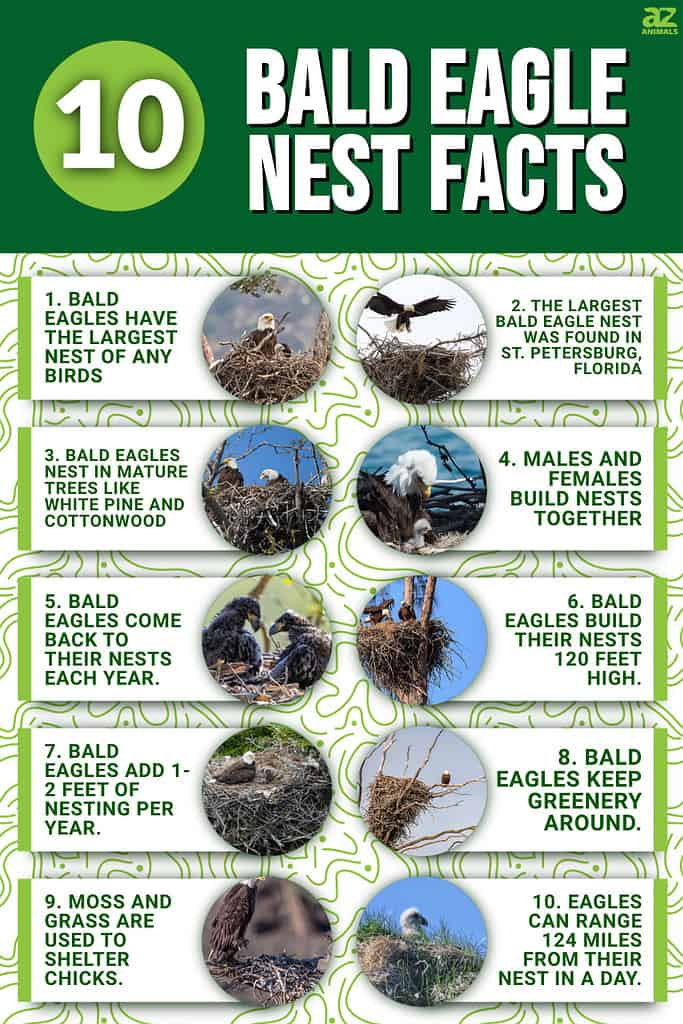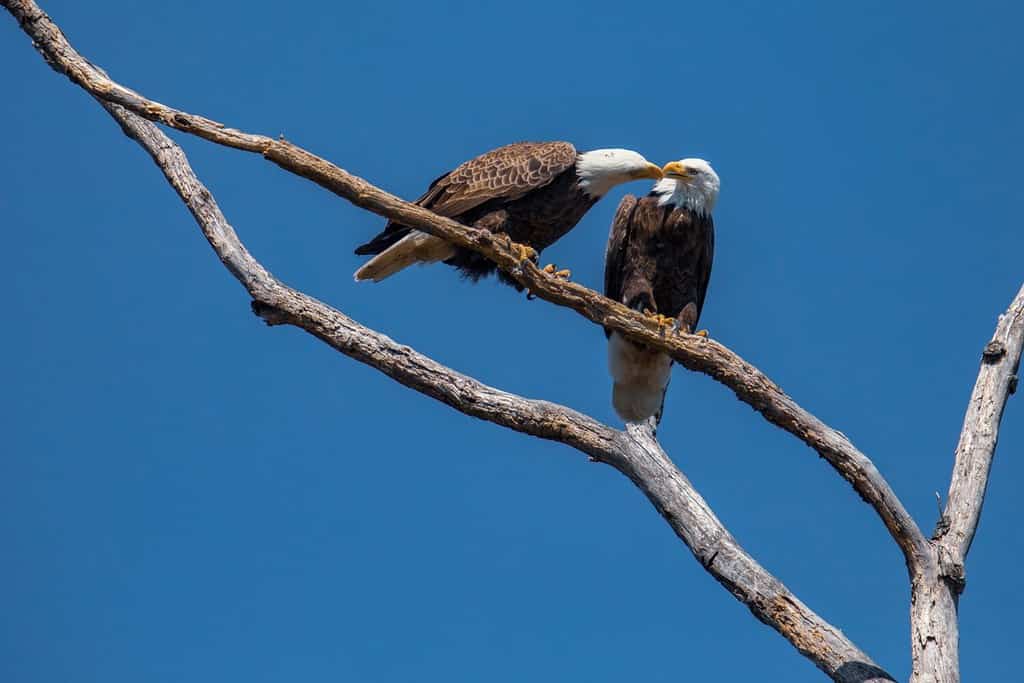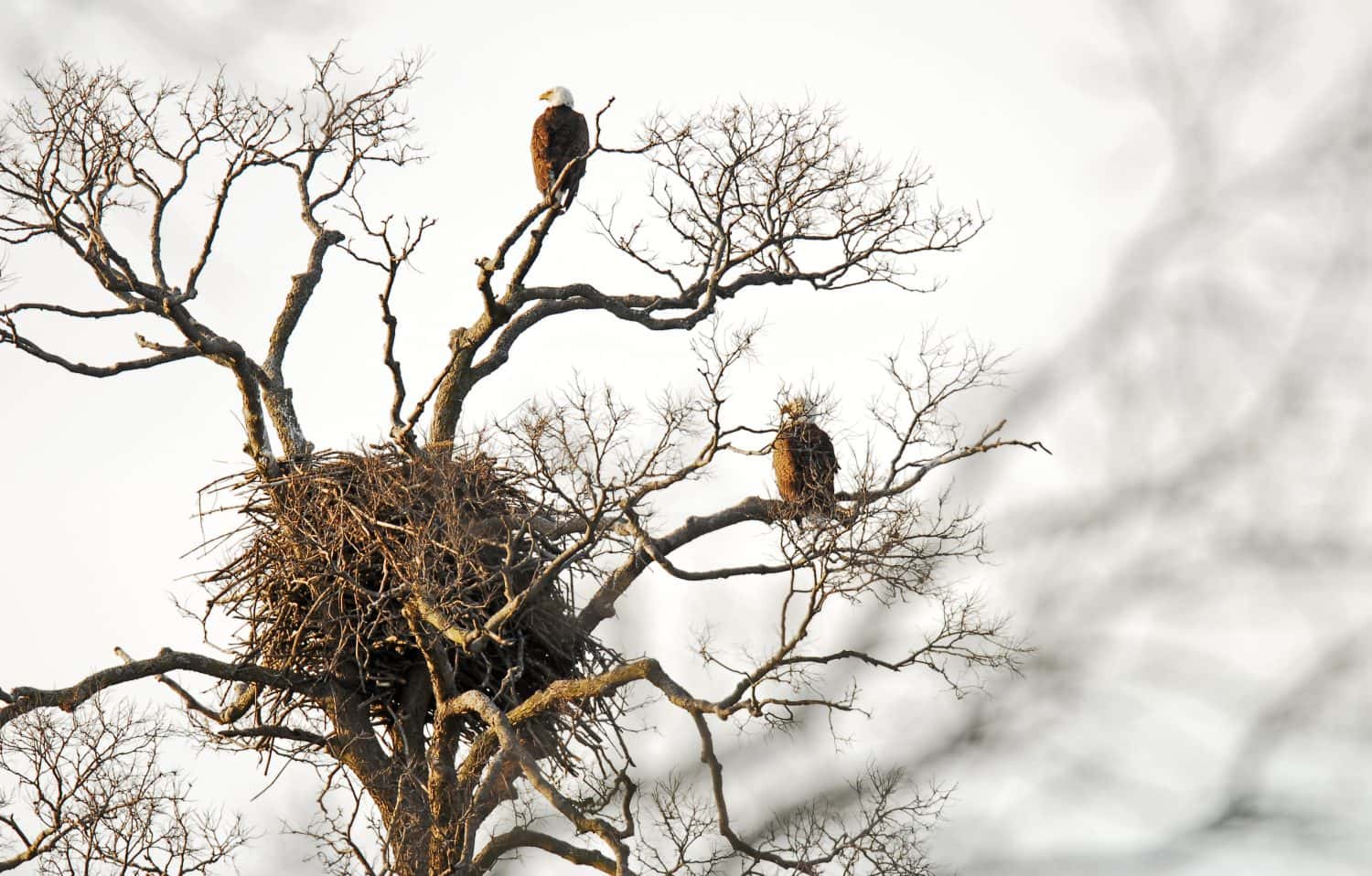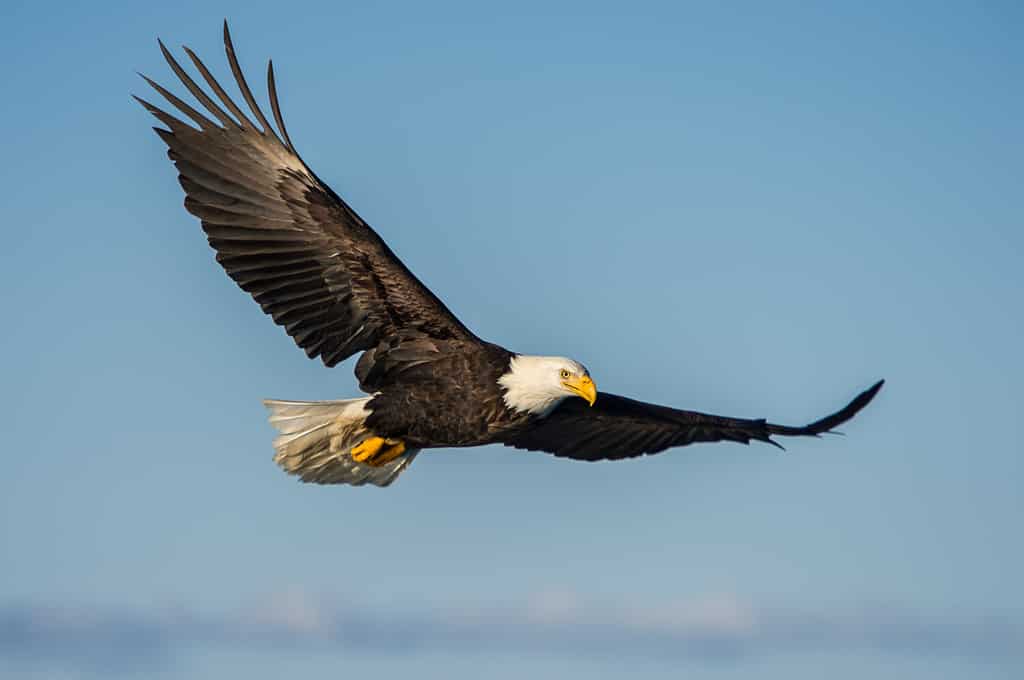Bald eagles aren’t just a cool national symbol for the United States; they are just cool all by themselves! One of the most distinguishing elements regarding bald eagles is their nesting habits. There are few birds that build nests like bald eagles and fewer who do it better. Let’s take a look at bald eagles and learn a few fun facts about their nests and nesting habits.

1. Bald Eagles Have the Largest Nest of Any Birds

Bald eagles have the largest nests of any bird species.
©KGrif/Shutterstock.com
Bald eagles are known for their nest size. In fact, bald eagles often have the largest nests of any bird in the entire world. On average, bald eagle nests are 4-5 feet wide and 2-4 feet deep. Where it really gets crazy is their size. A fully built bald eagle nest can weigh, on average, 1,000 lbs. For reference, the average cow can weigh 1,000 lbs!
2. The Largest Bald Eagle Nest Was Found in St. Petersburg, Florida

The largest bald eagle nest was found in St. Petersburg, Florida.
©Joseph Sohm/Shutterstock.com
While all bald eagle nests are large, the largest one ever found was in St. Petersburg, Florida. After it was measured, the final tally was 9.5 feet in diameter, 20 feet deep, and almost 6,000 lbs! The tree the nest was in was essentially supporting the weight of 3-4 cows! The main factors when it comes to size are the presence of trees that can support the weight, and the length of time spent on the nest itself.
3. Bald Eagles Nest in Mature Trees Like White Pine and Cottonwood

Reaching up to 180 feet tall, eastern white pines are popular nesting sites for bald eagles.
©Ukrolenochka/Shutterstock.com
Since bald eagles have such large nests, they prefer mature trees to support them. The most common trees that bald eagles will nest in are white pine or cottonwood trees. Aside from those two, they will nest in aspen, firs, oaks, and hickories, depending on availability. In the western states, eagles are also known to nest in rock crevices, outlooks, or any secluded high place.
4. Males and Females Build Nests Together

Male and female bald eagles share the responsibility of nest upkeep equally.
©EleanorAbramson/Shutterstock.com
Nesting isn’t a solo job! Eagles mate for life, and as a result, they share the responsibility of nesting. The female gathers material for the nest, but the male often helps out! Since they both live in the nest, it’s only right that they pitch in their fair share, right? Often, the male will provide food for the female when she is nesting with eggs, especially since they are generally better hunters since they are smaller.
5. Bald Eagles Come Back to Their Nests Each Year

Bald eagles tend to use the same nest every year.
©RLS Photo/Shutterstock.com
While a mating pair of eagles build their nest, they stay near it. When it’s finally time to lay the eggs, a parent is always around to protect the eggs. Once the chicks have finally hatched and moved on, however, the parents will take a much-needed break. They leave the nest uninhabited for some time but always come back each year in order to keep it tidy and potentially lay some new eggs. If they were unsuccessful in their mating or the chicks didn’t make it, they will often abandon the nest. Unless the nest is destroyed or abandoned, they will stay in them for years at a time. The oldest nest on record was in Vermillion, Ohio. It was used by eagles continually for 34 years.
6. Bald Eagles Build Their Nests 120 Feet High

Bald eagles choose nesting spots up to 125 feet high.
Image: Nancy Bauer, Shutterstock
©Nancy Bauer/Shutterstock.com
Most eagles build their nests between 50 and 125 feet high. The upper end is usually dependent on their environment (and what kind of trees are nearby). In the far north, where forests may be sparse, eagles will settle for smaller trees or even nest on the ground (although this is rare). In some places, the Channel Islands, for example, the eagles nest in caves and on cliffs in the absence of trees.
7. Bald Eagles Add 1-2 Feet of Nesting per Year

Bald eagles add up to two feet of material to their nest each year.
Image: Jon C. Beverly, Shutterstock
©Jon C. Beverly/Shutterstock.com
After eagles have an established nest, they will ensure the nest is tidy each year. Generally, they will add 1-2 feet of additional material each year, slowly accumulating. With this yearly growth, their nest sizes are able to grow to the aforementioned giants.
8. Bald Eagles Keep Greenery Around

Bald eagles will keep small bits of fresh greenery around their nests.
©iStock.com/PaulReevesPhotography
While it isn’t entirely known why, eagles will bring sprigs of greenery to their nests. One theory is that the fresh greenery repels insects, an important element for nesting chicks. Another theory may be that they use the greenery as a marker to other eagles to say, “Hey, this is occupied!” An additional theory is that they do it to provide camouflage. Here’s a crazy theory: maybe they just like it because they like it!
9. Moss and Grass are Used to Shelter Chicks

Spanish moss and grass is often used to make a bald eagle nest cozy and warm.
Image: Randall Vermillion, Shutterstock
©Randall Vermillion/Shutterstock.com
When a brood of eggs is on the way, the male and female eagles will get anything soft they can find. Spanish moss, moss, old man’s beard, grass, or even human fibers are ideal. Placing the soft material in the nest in a bowl-shaped pattern, can cushion the eggs and keep them from rolling around, while also providing warmth. Once they hatch, the bowl shape made from the moss acts as insulation and keeps them from falling out of the nest.
10. Eagles Can Range 124 Miles From Their Nest in a Day

Eagles protect a small territory around their nests but often range much further each day.
©FloridaStock/Shutterstock.com
Aside from bald eagle populations that migrate, a typical eagle can fly up to 124 miles away from its nest in a day. Since they fly at 31 mph while going long distances, the distance isn’t as difficult for them as it would be for any other land animal. During non-migratory seasons, they generally range 10-20 miles away from their nest. For most eagle couples, the 200 yards around a nest are defended as their own territory. When a female is nesting with eggs, the male will generally fly further as they are the resource gatherer for the family.
Summary of 10 Fun Facts About Eagle Nests
Knowing these fun facts will make you love Eagles even more:
| Fun Fact About Eagle Nests | |
|---|---|
| 1 | Bald eagles have the largest nest of any birds |
| 2 | The largest bald eagle nest was found in St. Petersburg, Florida |
| 3 | Bald eagles nest in mature trees like white pine and cottonwood |
| 4 | Males and females build nests together |
| 5 | Bald eagles come back to their nests each year |
| 6 | Bald eagles build their nests 120 feet high |
| 7 | Bald eagles add 1-2 feet of nesting per year |
| 8 | Bald eagles keep greenery around |
| 9 | Moss and grass are used to shelter chicks |
| 10 | Eagles can range 124 miles from their nest in a day |
The photo featured at the top of this post is © Tom Clausen/Shutterstock.com
Thank you for reading! Have some feedback for us? Contact the AZ Animals editorial team.






